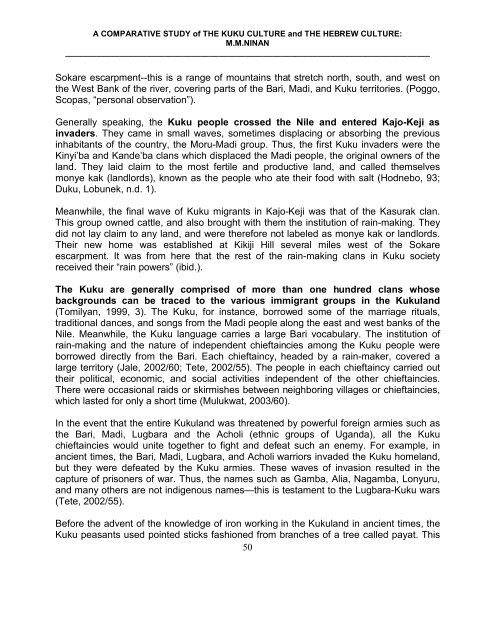kuku and Hebrew culture
Create successful ePaper yourself
Turn your PDF publications into a flip-book with our unique Google optimized e-Paper software.
A COMPARATIVE STUDY of THE KUKU CULTURE <strong>and</strong> THE HEBREW CULTURE:<br />
M.M.NINAN<br />
_________________________________________________________________________________<br />
Sokare escarpment--this is a range of mountains that stretch north, south, <strong>and</strong> west on<br />
the West Bank of the river, covering parts of the Bari, Madi, <strong>and</strong> Kuku territories. (Poggo,<br />
Scopas, “personal observation”).<br />
Generally speaking, the Kuku people crossed the Nile <strong>and</strong> entered Kajo-Keji as<br />
invaders. They came in small waves, sometimes displacing or absorbing the previous<br />
inhabitants of the country, the Moru-Madi group. Thus, the first Kuku invaders were the<br />
Kinyi’ba <strong>and</strong> K<strong>and</strong>e’ba clans which displaced the Madi people, the original owners of the<br />
l<strong>and</strong>. They laid claim to the most fertile <strong>and</strong> productive l<strong>and</strong>, <strong>and</strong> called themselves<br />
monye kak (l<strong>and</strong>lords), known as the people who ate their food with salt (Hodnebo, 93;<br />
Duku, Lobunek, n.d. 1).<br />
Meanwhile, the final wave of Kuku migrants in Kajo-Keji was that of the Kasurak clan.<br />
This group owned cattle, <strong>and</strong> also brought with them the institution of rain-making. They<br />
did not lay claim to any l<strong>and</strong>, <strong>and</strong> were therefore not labeled as monye kak or l<strong>and</strong>lords.<br />
Their new home was established at Kikiji Hill several miles west of the Sokare<br />
escarpment. It was from here that the rest of the rain-making clans in Kuku society<br />
received their “rain powers” (ibid.).<br />
The Kuku are generally comprised of more than one hundred clans whose<br />
backgrounds can be traced to the various immigrant groups in the Kukul<strong>and</strong><br />
(Tomilyan, 1999, 3). The Kuku, for instance, borrowed some of the marriage rituals,<br />
traditional dances, <strong>and</strong> songs from the Madi people along the east <strong>and</strong> west banks of the<br />
Nile. Meanwhile, the Kuku language carries a large Bari vocabulary. The institution of<br />
rain-making <strong>and</strong> the nature of independent chieftaincies among the Kuku people were<br />
borrowed directly from the Bari. Each chieftaincy, headed by a rain-maker, covered a<br />
large territory (Jale, 2002/60; Tete, 2002/55). The people in each chieftaincy carried out<br />
their political, economic, <strong>and</strong> social activities independent of the other chieftaincies.<br />
There were occasional raids or skirmishes between neighboring villages or chieftaincies,<br />
which lasted for only a short time (Mulukwat, 2003/60).<br />
In the event that the entire Kukul<strong>and</strong> was threatened by powerful foreign armies such as<br />
the Bari, Madi, Lugbara <strong>and</strong> the Acholi (ethnic groups of Ug<strong>and</strong>a), all the Kuku<br />
chieftaincies would unite together to fight <strong>and</strong> defeat such an enemy. For example, in<br />
ancient times, the Bari, Madi, Lugbara, <strong>and</strong> Acholi warriors invaded the Kuku homel<strong>and</strong>,<br />
but they were defeated by the Kuku armies. These waves of invasion resulted in the<br />
capture of prisoners of war. Thus, the names such as Gamba, Alia, Nagamba, Lonyuru,<br />
<strong>and</strong> many others are not indigenous names—this is testament to the Lugbara-Kuku wars<br />
(Tete, 2002/55).<br />
Before the advent of the knowledge of iron working in the Kukul<strong>and</strong> in ancient times, the<br />
Kuku peasants used pointed sticks fashioned from branches of a tree called payat. This<br />
50


















